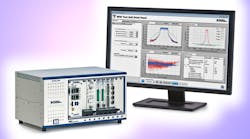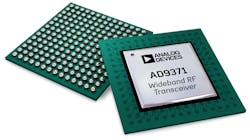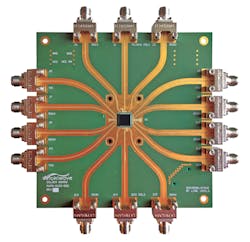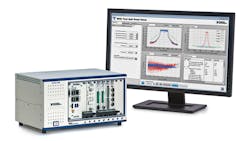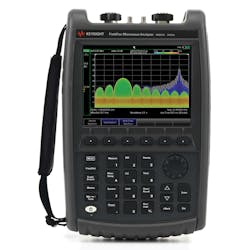This file type includes high resolution graphics and schematics when applicable.
Strong future demand looms over the RF/microwave industry, in the form of potentially huge, global commercial markets such as for Fifth-Generation (5G) wireless communications networks and Internet of Things (IoT) products. Even so, 2016 was a year of balanced business opportunities for many high-frequency companies.
Customers came with requirements for hardware, software, and test equipment to serve commercial, industrial, and military markets, while at times broaching new opportunities in medical and automotive electronics areas. To recognize a dozen of the innovative product solutions developed to meet these needs during the year, Microwaves & RF presents our picks for the Top New Products of 2016—a listing that combines value and performance, technology and design, and comes from companies large, small, established, and new alike. Congratulations are in order to all companies and engineering teams involved with bringing these products from block diagrams to production lines.
A number of these new products demonstrate impressive performance levels for their respective technologies through tight control of microscopic device features. On the electrical side, the model ADC32RF45 dual-channel analog-to-digital converter (ADC) from Texas Instruments enables direct sampling of S-band radar receiver signals by means of its 3 GSamples/s per channel sampling capabilities. It can digitize modulated input signals from dc to 1.25 GHz, such as in-phase (I) and quadrature (Q) signal components, with high, 14-b resolution and can process input signals to 4 GHz.
On the mechanical side, several companies brought microelectromechanical-systems (MEMS) technology to the forefront with quite accessible, commercial products. For example, Analog Devices introduced its ADGM1304 and ADGM1004 single-pole, four-throw (SP4T) MEMS switches with true dc-coupled operation to 14 GHz. To make things simple, each MEMS switch is packaged with a low-voltage TTL/CMOS-compatible switch driver. These components dispel some of the early myths associated with MEMS technology in terms of switching speed and reliability, since they are capable of microsecond switching speeds and rated for billions of switching cycles.
MEMS technology is also the basis for a line of silicon timing oscillators from SiTime, with clock frequencies of 1 to 220 MHz and differential outputs as high as 700 MHz. The Elite Platform MEMS oscillators are a fraction of the size and power consumption of the temperature-compensated crystal oscillators (TCXOs) and oven-controlled crystal oscillators (OCXOs) they replace. The MEMS oscillators follow the industry’s trend of circuit densification with miniaturization, fitting a pair of SiTime’s DualMEMS MEMS resonators—one for timing and one for temperature sensing—in a miniature package with a mixed-signal silicon CMOS IC. The end result is outstanding frequency stability even with rapid fluctuations in temperature and power supply.
Analog Devices also made progress in traditional semiconductor IC technology with their RadioVerse AD9371 direct-conversion transceiver. It packs the functionality and performance needed for 4G and 5G wireless networks with multiple radios on a single device (Fig. 1). The transceiver doesn’t require a local oscillator (LO) since the IC contains multiple voltage-controlled oscillators (VCOs) and three fractional-N phase-locked loops (PLLs) for stable frequency generation.
The AD9371 has a frequency range of 300 MHz to 6 GHz with channel bandwidths as wide as 100 MHz, offering total control of two independent transmitter paths and two independent receiver paths. The differential transmitters and receivers can be programmed for frequency-division-duplex (FDD) and time-division-duplex (TDD) operation for use in current and future wireless communications networks.
Broadband amplification is essential for many communications networks, and RF/microwave system designers have come to terms with the gradual drop in signal gain that comes with increasing frequency—all except broadband amplifier designers at Custom MMIC. The company’s BroadRange distributed amplifiers cover a total frequency range of dc to 22 GHz with a unique positive gain slope, allowing system designers to overcome losses from passive components elsewhere in a communications or even electronic-warfare (EW) system, such as filters and couplers. The amplifiers include on-chip tracking circuits to compensate for changing temperature and other environmental effects, and the positive gain slope makes it possible to eliminate gain equalizers from a system design.
To fill the growing need for compact printed-circuit-board (PCB) antennas for the current Fourth-Generation (4G) and coming 5G wireless communications networks, circuit-material-supplier Rogers Corp. created its RO4730G laminates. These are 94 V-0 antenna-grade laminates well suited for printed-circuit antennas in wireless base-transceiver station (BTS) and microcell applications. They feature a dielectric constant of 3.00 maintained to a tolerance of ±0.05 through the z-axis (thickness) of the material as measured at 10 GHz. The circuit material also boasts outstanding passive intermodulation (PIM) performance, as low as −160 dBc, for high-frequency antennas with clean responses.
Making Waves
As wireless services and products continue to consume bandwidth, designers look to higher frequencies to place communications channels—and even to millimeter-wave frequencies. Recognizing the growing need for affordable millimeter-wave circuit-design capabilities, Anokiwave is a fabless semiconductor company that weighs the benefits of available semiconductor processes in an attempt to fit the process to the performance need.
The fabless semiconductor company is attempting to bring millimeter-wave technology to the masses by matching a semiconductor process to a function, such as gallium arsenide (GaAs) for low-noise amplification, silicon CMOS for logic, and gallium nitride (GaN) for high-frequency power amplification. The firm has developed a number of different ICs, including quad-core transceivers with electronically steerable antenna arrays operable to 30 GHz, GaAs-based low-noise amplifiers (LNAs) for bands from 71 to 86 GHz, and GaN-based power amplifiers (PAs) to 86 GHz, that are available as part of test circuit boards in Developer Kits (Fig. 2; 40GFIG2).
The industry move toward more practical millimeter-wave solutions was also echoed by Peregrine Semiconductor with its UltraCMOS silicon-on-insulator (SOI) semiconductor process and a pair of switches capable of operation from 9 kHz to 60 GHz. The reflective switches feature 8-ns switching speed, and one is designed for extended operating temperatures (such as for industrial and military applications).
New test equipment occupies a healthy portion of our picks for 2016, with nice advances made by many of the “usual suspects.” The industry trend toward achieving smaller size with higher density was certainly not absent among designers of test gear. In response to the growing need of mobile communications networks for better high-frequency measurements in the field, the RSA500A and RSA600A Series battery-powered spectrum analyzers from Tektronix represent a dramatic miniaturization of the portable spectrum analyzers the company once offered.
With frequency coverage as wide as 9 kHz to 7.5 GHz and analysis bandwidths as wide as 40 MHz, the compact instruments keep essential analysis functions in the box and move command, control, and display functions to a PC via USB cable. These analyzers measure just 11.78 × 10.68 × 2.65 in. (299.1 × 271.3 × 67.3 mm) and weigh just 6.6 lb. 2.99 kg) with rechargeable lithium-ion battery.
National Instruments continued its “mastery over the modular” by introducing its PXIe-5840R vector signal transceiver (VST). In what would have once occupied multiple spaces in a 19-in.-wide instrument rack, this software-driven modular test system fits within a pair of PXIe modules. These miniature modules (Fig. 3) include a fast switching signal generator and wideband signal analyzer along with a user-programmable field-programmable gate array (FPGA) and high-speed digital interface for rapid transfer of test data.
They combine for a 1-GHz instantaneous analysis bandwidth spanning 9 kHz to 6.5 GHz. The modules combine the essential functions of an RF/microwave test instrument with a PC. The modular instrument can be commanded and controlled with a PC running the company’s LabVIEW design and test software.
Keysight Technologies did its part for improved in-field RF/microwave measurements in 2016 with its latest additions to its FieldFox portable signal and spectrum analyzer product line (Fig. 4). Available with optional real-time-spectrum-analysis (RTSA) capability, the instruments can test real-time analysis bandwidths as wide as 10 MHz across a frequency range as wide as 9 kHz to 50 GHz.
The compact battery-powered instruments provide the measurement capabilities for testing across a wide range of markets and applications, with spectrum analyzers, vector network analyzers (VNAs), and cable and antenna testers (CATs) along with built-in power meters, frequency counters, and even GPS receivers for precise location information of detected signals. They measure just 11.5 ×7.4 × 2.8 in. (292 ×188 × 72 mm) with a 6.5-in. diagonal thin-film-transistor (TFT) display and weigh just 7.1 lb. (3.2 kg). Additional options provide pulse characterization capability for in-field testing of electronic-warfare (EW) and radar systems.
Keysight didn’t forget those working at the benchtop, with their X-Series signal analyzers extending frequency coverage from 3 Hz to 50 GHz. These instruments show results on 14.1- or 10.6-in. multiple-touch capacitive display screens. With phase-noise performance as good as −136 dBc/Hz offset 10 kHz from a 1-GHz carrier, these analyzers work with a library of test software to handle a wide range of signal-analysis chores, from commercial communications to military pulsed radar testing.
This file type includes high resolution graphics and schematics when applicable.
